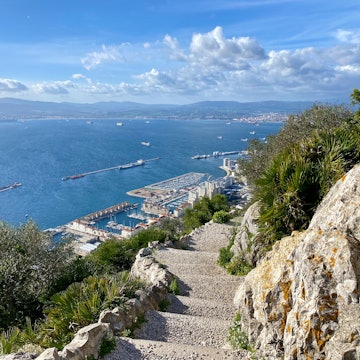

Spain's bus network covers its major cities, coastal villages, mountainous landscapes and everywhere in between. Angelo DAmico/Shutterstock
As the largest country in Southern Europe, Spain is a destination with distinctive cultures, landscapes and languages – and its extensive bus network can help you explore it all.
High-speed trains connect the country fairly well, converging on its central capital, Madrid, but they can’t get you everywhere. For everywhere wild and rural in between, having a car is the easiest way to get around. However, when you’re on a budget, traveling solo, or aiming for more sustainable travel, the bus is best.
From long intercity trips to short seasonal routes, here’s everything you need to know about bus travel in Spain.

How to take a bus in Spain
With most of the country’s population living in major urban hubs, popular destinations are well connected, and there are frequent departures between big cities like Madrid, Valencia, and Barcelona. Only about two thirds of Spanish residents hold a driver’s license, so there tends to be many alternative ways to reach smaller cities and even very rural regions if you’re willing to do a little digging.
What is the cost and booking of a bus in Spain?
Traveling by bus is not always cheaper – especially on trips longer than four hours – but sometimes it is the only option if there is no train line or airport where you’re going. You will find the best fares on high-traffic routes. Most of the time, these routes are also connected by train services, which are usually better value for a shorter transit time.
Most companies allow you to book your tickets in advance, but only some routes offer seat selection. There may be a few rare times when it’s not possible to buy ahead of time, especially with a smaller bus company, so you will have to show up early and pay when you get on the bus. Bus drivers will usually accept credit cards but it’s always good to have cash on hand just in case.
Book your ticket in advance as soon as you’ve decided on your travel plans, especially if you’re traveling to a popular day trip destination from a major city. I made this mistake one day in Barcelona when I decided to take a spur-of-the-moment trip up to the medieval beach town of Tossa de Mar on a Thursday morning – I got all the way to the bus station just to find out it was already sold out. Always check online first because some websites will display how many seats are left.

How to find discounts or offers for a bus in Spain
Discounted tickets are generally, but not always, available for seniors and young adults (25 and under), as well as children and infants. While searching for tickets you can look for discounts or bonos (bonuses) that can sometimes save you up to 50% on selected routes. If you plan to ride the same line multiple times, some companies like ALSA offer a “bono gratuito” ticket. This special bono allows for unlimited bus travel within a certain timeframe, but only for one route.
Bus occupancy and route types
If you plan on using public buses in a major city, you can expect them to be full at rush hour between 8am and 9am and between 5pm and 7pm. In my experience living in Barcelona, buses tend to be more full on the weekends from the early afternoon into the night, especially on routes that go to the beach or pass through the city center.
For regional transportation, service frequency is usually increased at times of high demand such as weekends and for holidays including Semana Santa (the week before Easter when most Spaniards have vacation days). There might be more departures around a holiday, but you should still book your tickets and accommodations way in advance. Weekends can also be busy depending on the season and destination.

How to connect on a bus in Spain
Standing in the ticketing wing of a busy Spanish bus station, you will see that there are dozens of different bus companies like ALSA, the largest intercity operator in Spain, as well as Europe-wide lines like FlixBus and BlaBlaBus, which can take you as far as Paris, Berlin and Milan. Smaller companies operate regionally, such as Moventis, which operates in Catalonia, and MonBus and Avanza, which operate in multiple regions including Galicia and Andalucía.
It’s common that one company has dominion over a certain region. For example, in Catalonia you will need to check ALSA for connections to the Pyrenees, and Moventis for traveling on the Costa Brava. With so much variety, the best way to find out what bus to take is to check a travel planning website like Rome2Rio or BusBud and plug in your origin and destinations.
However, these websites often don’t include information about the seasonal bus routes that run in service of tourism in the high season. As I discovered in Catalonia, these can be game-changers when it comes to travel planning, with services including Rumbus, which ferries visitors to the trailheads in La Garrotxa Natural Park, and Julivia Bus, which travels to the smaller coastal villages near Palafrugell. For this reason, it’s always worth checking local tourism sources to see if they offer something similar.
Luggage rules and wi-fi availability
Public buses are different from city to city and, while reliability varies, they are generally all pretty clean and safe. Long-haul and regional bus services may include a WC, wi-fi and outlets on board, but not always. Quality also varies from company to company. From personal experience, I’ve found ALSA to be the most comfortable.
There's usually a complimentary luggage allowance, but you might be charged extra if you have more than one bag over 20kg. Bikes are carried free of charge on certain routes, and pets are sometimes allowed for an extra fee, but they must meet vaccination and other requirements specific to each company. Service animals typically ride free.

Scenic bus routes in Spain
Most of the time, bus travel in Spain is a convenient option, but sometimes it’s also a great way to relax and enjoy the scenery. Here are some of the top bus routes that can take you past fantastically scenic destinations.
Palma to Port de Sóller
Get to the small villages of Mallorca’s Tramuntana mountain range – and save yourself time looking for parking – on Line 301. You can take the historic train from Palma to Sóller first and then connect to Port de Sóller by tram, before getting the bus back. Sit on the right for ocean views and hop off for sightseeing in the towns of Deià and Valldemossa.
Roses to Cadaqués
On the northernmost point of the Costa Brava, you can enjoy the fabulous mountain pass road between the beach town of Roses and the posh village of Cadaqués. The road down is winding so either side will have great views. Once in Cadaqués, you can connect to the lighthouse in the natural park by local bus.Seville to Ronda
Seville to Ronda
Make your way to the famous gorge-spanning town of Ronda from Seville to enjoy views of the Sierra de Grazalema Natural Park, a gem of Andalucía, on the right.
Santiago de Compostela to Fisterra
Access the wild beauty of Galicia’s Atlantic coast on this journey from Santiago de Compostela, the end of the Camino, to Fisterra. You’ll head west and then follow the coastal road north, so get a seat on the left.
Santander to Fuente Dé
Travel from Cantabria’s coastal capital to the wild and pastoral landscape of Picos de Europa National Park. You will need to stop in Potes to get a second bus to Fuente Dé, but from here you can take the cable car and continue your automobile-free journey all the way up to the mountaintop.

Tips for traveling by bus in Spain
In large cities, you’ll typically find a small cafe or a few shops at the bus station, but this is unusual for small towns, where there might only be a few buses per day. If you’re lucky, there will be a vending machine and a bathroom but, if not, you might need to take a walk to a nearby cafe. Always bring extra food and water in case the shops are closed during your transfer. Arrive at least 15 minutes before the bus leaves so you have time to confirm you’re in the right spot.
Accessibility on buses in Spain
Throughout Spain, autonomous mobility is a priority and although it might vary between cities and different bus lines, most services are accessible for passengers with disabilities. Urban buses in Madrid and Barcelona have designated areas for wheelchairs, and regional buses are often equipped to accommodate wheelchair users, even including discounted fares for companions. However, this is a case of “usually” and not “always,” so it’s still strongly advised to research the service provider beforehand to confirm.
















